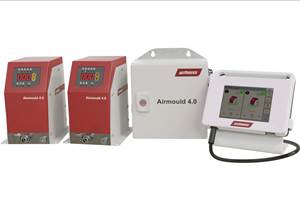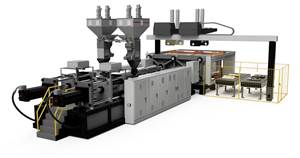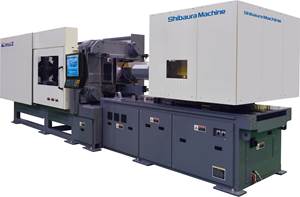New Molding & Tooling Technologies In the Pipeline at Germany's IKV
Software that helps you select the right rapid-tooling method for your application, fresh approaches to multi-component injection molding, and new techniques for LSR foaming and micro-molding are some of the top projects being investigated at the Institute fur Kunststoffverarbeitung (Institute for Plastics Processing) or IKV in Aachen, Germany.
Software that helps you select the right rapid-tooling method for your application, fresh approaches to multi-component injection molding, and new techniques for LSR foaming and micro-molding are some of the top projects being investigated at the Institute fur Kunststoffverarbeitung (Institute for Plastics Processing) or IKV in Aachen, Germany. This world-famous R&D institute has been the cradle for development of numerous technologies such as water-assist injection molding. A visit in May provided this exclusive peek at new developments expected to come to fruition within one to three years.
‘Wizard’ picks rapid tooling
Rapid tooling (RT) has grown to encompass a diverse range of methods for creating molds quickly. Since different RT methods yield different costs and performance results, processors could use some help in evaluating the various approaches and selecting the one most suited to their needs. Developing a software “wizard” for that task is the project of Michael Schoenfeld, part of the IKV’s team for Rapid Prototyping and Rapid Tooling. Schoenfeld expects to evaluate up to 10 RT technologies in terms of heat transfer, surface quality, hardness, density, build time, accuracy, and other properties. The Windows-based software prompts users to enter parameters such as shot weight, material type, part dimensions, and number of parts to be molded. The software then evaluates a succession of pairs of RT processes to show the possibilities and limits of each technology.
Multi-component plus . . .
Given today’s intense interest in multi-component molding, IKV researchers are looking to expand its capabilities by combining process techniques in new ways. One project pairs multi-component and fluid-assist (gas or water) molding for production of thick, elongated articles with complex shapes, such as automotive pedals and arm rests. Says Christoph Lettowsky, an IKV engineer, the combined technologies could save material, cut cycle time, part weight, and cost.
For example, multi-component, fluid-assist molding could allow replacement of short-glass-filled nylon with less expensive polypropylene. The skin of the part could be PP reinforced with long glass fibers—not usually suitable for fluid-assist molding—while a more process-friendly unfilled PP would be used in the core of the part, where the fluid assist takes place.
The IKV is also researching injection-compression molding of coinjected or sandwich molded structures as a means to produce thin-wall parts with im proved mechanical properties and surface finish. Three-stage coinjection of skin, core, and then skin again is followed by compression of the sandwich by fully closing the mold. The low-pressure compression stage and the uniform material compaction lead to a low degree of material orientation, according to Lettowsky. This produces less shrink age and warpage and a more uniform core-to-skin distribution, he adds.
Investigating adhesion
Growth in multi-component parts with hard/soft characteristics is spurring research in the area of adhesion between hard and soft resins. “Up to now the adhesion of polymer combinations produced by multi-component molding could not be predicted in a reliable way. The knowledge about adhesive mechanisms as well as the influence of outside parameters, such as the process or part geometry, were limited,” says Lettowsky.
The IKV has tested adhesion of SEBS-based TPEs and TPUs to thermoplastics like PP, PBT, and a wide variety of nylons. Thermoplastics were also tested with adhesion-modified LSR grades from Wacker Chemie in Germany (parent of Wacker Silicones in Adrian, Mich.). A six-cavity test mold was created with interchangeable plates that permit varying the type and position of gating as well as the part thickness, surface roughness, and contour of the boundary layers between materials. Effects of processing factors like mold temperature and injection speed were also tested. Researchers subjected the two-component samples to tensile and peel tests to observe the adhesive strength.
Lettowsky says one major discovery is the importance of tool design and processing in addition to the inherent compatibility of different material compositions. Adhesion is affected significantly by the way the materials flow together in the mold, the surface roughness, and mold temperature.
Water injection goes soft
Although it’s too early to discuss results, IKV engineers Tim Juentgen and Oliver Groenlund are exploring the intriguing possibilities of making complex hollow parts that are also flexible. The new technique of water injection molding so far has been used only with rigid materials, but the IKV wants to see what happens with SEBS-type TPEs of 60 to 80 Shore A hardness. Juentgen and Groenlund speculate that their research could point the way to automotive under-hood manifolds that could be pushed and pulled to fit together with other components.
LSR foams & micro-molding
Another unusual avenue of research at the IKV is foaming of liquid silicone and use of LSR in micro-molding. Schoenfeld says the IKV is developing a torpedo-style injection nozzle for introducing nitrogen gas into the LSR just before the mix is injected into the mold. In the past, foaming LSR has been difficult because of the material’s low viscosity, Schoenfeld notes.
A novel technique for injection molding LSR micro parts is also being tested. The goal is to mold very small parts without flash, despite LSR’s very low viscosity. The method depends on taking advantage of LSR’s tendency to expand when heated. Material from the injection barrel is at 68 to 104 F when it enters the hot mold cavity at 320 F to 428 F. IKV designed the mold with a large runner and tiny cavities that are used like overflow wells in gas-assist molding. LSR is injected in a short shot to fill only the runner, but as the material heats and expands it fills the tiny cavities at relatively low pressure.
Related Content
Internal Gas Pressure Molding Offers Sustainability Benefits
Wittmann Battenfeld says its upgraded Airmould 4.0 technology, which features a more compact footprint, saves material and cycle time — thereby also cutting energy use.
Read MoreStructural Foam Injection Molding Line Extended
At K 2022, Wilmington Machinery introduced the dual-injection Lumina MP1200 medium pressure molding machine.
Read MoreCompletely Connected Molding
NPE2024: Medical, inmold labeling, core-back molding and Industry 4.0 technologies on display at Shibaura’s booth.
Read MoreFakuma 2023: Wittmann Battenfeld Expands All-Electric Line, Direct-Current Capabilities
Wittmann Battenfeld will introduce the new EcoPower B8X injection molding machine line and show direct current as an energy source for a concept machine that will power its own robot.
Read MoreRead Next
Why (and What) You Need to Dry
Other than polyolefins, almost every other polymer exhibits some level of polarity and therefore can absorb a certain amount of moisture from the atmosphere. Here’s a look at some of these materials, and what needs to be done to dry them.
Read MoreTroubleshooting Screw and Barrel Wear in Extrusion
Extruder screws and barrels will wear over time. If you are seeing a reduction in specific rate and higher discharge temperatures, wear is the likely culprit.
Read More








.png;maxWidth=300;quality=90)














